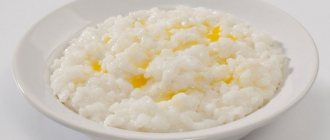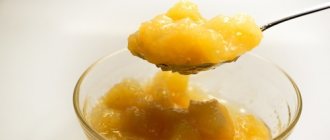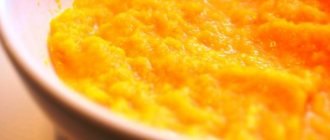Every mother chooses only the best cereals for the first feeding. The child grows so quickly that already in the third or fourth month of his life, parents have a question: What to choose for complementary feeding? How to check the composition? All cereals that are sold in stores are divided into several types: with gluten and without gluten. Porridge is an important element of a child’s diet; all pediatricians recommend introducing foods containing buckwheat or rice flakes into the diet. The rating of cereals for the first feeding was prepared taking into account reviews and ratings left by customers, as well as based on the advice of pediatricians.
The need, advantages and disadvantages of complementary feeding at 3 months
For adequate nutrition, growth and weight gain at 3 months of age, a child’s mother’s milk is enough and adding a drop of juice or puree to him, as a doctor once taught us, is completely unnecessary.
The baby may develop disorders, regurgitation or vomiting, allergies, disruption of internal organs - all this can lead to failure of breastfeeding. At this age, babies still suffer from colic, although they are already accustomed to breast milk and it will be even more difficult for them to accept new food.
At this age, digestive enzymes are still poorly produced, so the intestinal mucosa is vulnerable to harmful substances. In addition, the swallowing reflex for semi-liquid and solid foods is still poorly developed. All these features will lose their relevance in just one or two months, so if there are no clear reasons for starting complementary feeding at 3 months, it makes sense to wait a little.
It’s another matter if we are talking about premature babies or if for some reason the baby does not receive mother’s milk, he has:
- there is underweight
- bowel problems and excessive gas production
- lack of fats, proteins, vitamins, enzymes and microelements
- allergy to milk powder and formula
In this case, early complementary feeding is really useful and necessary, but you need to start it not with juices and purees, but rather with dairy-free cereals and kefir.
Prohibition on early complementary feeding
Why is early complementary feeding still not recommended for three-month-old babies by most pediatricians? Indeed, in Soviet times, almost everyone began to feed their babies with fruit purees and juices from this age. Those who oppose early complementary feeding of children from 3 months have their own arguments:
- according to WHO (World Health Organization) regulations, the first feeding of babies should begin at 4.5–5.5 months;
- the physiological characteristics of three-month-old babies indicate that the body is not ready to accept adult food;
- The ideal food for a baby is mother's milk, so it is especially undesirable to transfer a three-month-old baby to adult food if he is breastfed: thereby, parents deprive him of a very valuable product, which only has a positive effect on his further development;
- if you rush into this issue, early complementary feeding can provoke the appearance of quite serious diseases, which will negatively affect the health and development of the child in the future - this is the main argument of those who speak out against early complementary feeding.
Useful: Teaching your baby to roll over on his own
Today, many doctors who worked back in Soviet times, or old-fashioned grandmothers, can advise young parents to start feeding their babies fruit juices from 3 months. Before following these tips, you need to weigh the pros and cons so as not to harm your child. Indeed, among the consequences of early complementary feeding are quite serious diseases.
The consequences of early complementary feeding may not manifest themselves immediately, but much later - at school age
Features of complementary feeding for artificial and infants
Formula-fed babies are ready for complementary feeding earlier than infants. This is explained simply. The stomach and intestines of the artificial child get used to coarser, foreign food much earlier. It is also necessary to take into account that the mixture does not cover the baby’s needs for vitamins, minerals and amino acids, and already at the age of 3-4 months, complementary feeding is really necessary.
Voting for the best porridge for first feeding
Which porridge would you choose or recommend for first feeding?
Bebi hypoallergenic porridge
0.00 % ( 0 )
Fleur Alpine 3 grains
0.00 % ( 0 )
Fleur Alpine with prebiotics
0.00 % ( 0 )
Hipp buckwheat porridge
0.00 % ( 0 )
Baby Sitter rice (from 4 months)
0.00 % ( 0 )
Gerber buckwheat
0.00 % ( 0 )
Nestle hypoallergenic dairy-free porridge
100.00 % ( 2 )
Semper buckwheat
0.00 % ( 0 )
Rules for correctly entering products
Competent complementary feeding is a whole science; doctors even advise young mothers to keep a diary, where they indicate not only the product, but also its dosage.
- Complementary foods are given to the baby before breastfeeding. The amount of product gradually increases and the amount of milk in feeding decreases. As a result, the new dish should completely replace one breast or formula feeding.
- Products are introduced strictly one at a time, starting with the minimum dose. First you offer your child 5 grams, no more than ½ teaspoon. The next day 10-15, then 25-30 and gradually increase the rate to 50, 100 and 150 grams. This should take you 7-10 days.
- Complementary feeding begins at 3 months with monocomponent puree. Only after the baby has safely accepted the first product can you introduce him to a new one. If an allergy or disorder appears, the introduction of a new dish must be stopped.
- It is prohibited to offer your child the same complementary foods several times a day.
- It is better to refrain from fruits that are not native to our region and give preference to apples, pears and apricots.
- By the age of one, almost all breastfeeding or formula feeding should be replaced with complementary foods, leaving only milk in the morning and at night. If you want to continue breastfeeding, your baby can additionally eat breast milk at night.
- Do not offer your baby complementary foods or new foods during teething or illness.
- The baby should be fed only with a spoon. Young mothers continue to use silver appliances because silver is known to kill bacteria.
What types of baby cereals are there?
There are two main groups of cereals - with and without dairy products. Cow's milk is not always healthy; it is one of the most powerful allergens, which is not recommended for infants.
Choosing porridge for the first feeding
On sale you can find the following porridge options:
- one-component - from one cereal;
- multicomponent - from 2-3 cereals;
- with yogurt, cookie crumbs or cottage cheese;
- with dried fruits.
For babies from three months old, only simple cereals are suitable - one- and two-component, without any additives.
Advice! If the child has not yet eaten any porridge, it is best to start complementary feeding with a single-ingredient one, this will make it easier to understand the cause of the allergy if the baby is covered with red spots.
Nutrition standards
For full growth and weight gain, the toddler must receive the required amount of vitamins, minerals, nutrients and nutrients every day. That is why every mother must calculate how much food her child needs to consume. This is not difficult to do.
The baby’s weight should be divided by 6 - this will be the daily volume, which, in turn, should be divided into several doses.
For example, a child weighs 6.5 kg. Its daily intake is 1.08 kg, which must be divided into an average of 6 - 7 feedings. This means that the baby should eat about 150-180 grams at a time. And between meals you need to wait an average of 3.5 hours.
There is a time for everything: we select baby porridge according to the baby’s age
After analyzing all the features of a child’s growth and development in the first years of life, Heinz experts developed baby cereals taking into account the age-related needs of babies.
- At 4 months, the child is already ready to introduce complementary foods, but the baby’s digestive tract will mature throughout the first year of the baby’s life.
The digestive system of a 4-6 month old child can digest and absorb without discomfort in the tummy only mono-products with a special degree of grinding (homogeneity) and a composition selected for such a tender age. It is also important to remember that at this age the normal intestinal microflora continues to form. Colic is also possible, and difficulties with stool frequency may arise. That is why it is necessary to choose first complementary foods that will promote healthy digestion.
When introducing the first complementary foods, it is important to choose foods with potentially low allergenicity for the baby.
The ideal start for complementary feeding is products that are balanced in vitamin and mineral composition, since at the age of 4-6 months the baby’s need for vitamins and minerals increases, and a balanced composition helps reduce the risk of developing iron deficiency anemia.
During the period of introducing the first complementary foods at 4-6 months, many mothers stop breastfeeding, this cannot but affect the immune system. That is why, when introducing complementary foods, it is important to pay attention to foods that help strengthen and build immunity.
Taking all these factors into account, Heinz has developed a special line of low-allergenic cereals for starting complementary feeding. They contain only one type of cereal without added milk or sugar. Additionally, all Heinz cereals are enriched with a vitamin-mineral complex of 4 minerals (calcium, iron, zinc, iodine) and 12 vitamins (A, D, E, B1, B2, B6, B12, PP, C, folic acid, biotin, pantothenic acid ). The porridge also contains natural prebiotics that promote comfortable digestion for the child.
- At 6 months the child becomes more active. He begins to crawl, sways, kneels, and tries to sit down.
This is a very important period for the formation of the musculoskeletal system, active teething begins and the need for calcium and vitamin D increases. The digestive system moves to a new level of development and is ready to digest more complex components, not only plant, but also animal proteins. The need for iron, vitamins A, D and group B increases.
For this age, Heinz experts have developed a special line of milk porridges, which contain whole natural milk, without the addition of vegetable fats. Many milk porridges are based on a combination of cereals, as well as natural fruit purees and juices.
All Heinz cereals contain inulin and oligofructose from chicory, which are natural prebiotics of plant origin. Inulin and oligofructose also promote calcium absorption and have a beneficial effect on lipid metabolism.
- At 9 months, the baby gets up, walks around the playpen, and his weight and height increase.
A nine-month-old child already understands what adults want from him, and, if asked, can perform some simple actions. Brain development continues. The need for various plant proteins is increasing - the composition of food must become more diverse in order to fully provide the baby with nutrients for its proper and harmonious development.
The main task of parents at this stage is to make the baby’s nutrition as varied as possible in terms of the set of components. Animal fat and protein are required, which can be supplied with milk porridge, and dietary fiber, organic acids, key vitamins and, of course, iron, phosphorus, calcium and iodine. Food should be varied in taste, since the baby develops an organoleptic (taste) perception.
Especially for this age, the Heinz company has developed a line of “Tasty Porridges”, in which the milk content is up to 40%. The wide range and high nutritional value of Heinz cereals allow you to choose the best complementary feeding option for each child. Heinz cereals are very popular among mothers. In Russia, Heinz baby cereals received the honorary title “Moms’ Choice No. 1″*.
- At 12 months, the baby has a sufficient number of teeth to develop chewing skills and taste preferences begin to form.
Every year a child needs even more vitamins and minerals, the baby is constantly on the move, and the active development of the nervous system continues. More and more strength and energy is required every day. During this period, the main tasks are to provide a varied menu for the child so that the baby receives the entire necessary range of microelements, as well as gradual preparation for the transition to an adult diet (by 2-2.5 years).
That is why Heinz company experts have developed a special line of Lyubopyshki cereals for children from 1 to 3 years old. “Lyubopyshki” porridges contain the necessary amount of vitamins and minerals for the proper development of the baby. The main difference from porridges “up to a year” is the presence in their composition of pieces of fruit and grain flakes, which are necessary for the proper development of a child’s chewing skills and the formation of taste preferences.
“Lyubopyshki” porridges are also enriched with prebiotic chicory fibers, which helps ensure comfortable digestion, strengthens the immune system and prevents the development of allergies.
As an advertisement. Breast milk is the healthiest thing for your baby. Before introducing complementary foods, consult your pediatrician. The age for introducing foods is indicated on the packaging.
*Based on Baby Index research. “Products and services for children under 4 years of age: preferences of mothers” 2013/I wave, conducted by Synovate Comcon LLC
Choosing the first product
What product should you start with when getting acquainted with adult food? After all, you want complementary feeding at the age of 3 months to be as beneficial as possible. Pediatricians are not unanimous in their decision.
The diet, developed by the Ministry of Health back in the USSR, states that acquaintance with adult food should begin with fruit juice, which is literally given to the baby drop by drop. This is what our mothers did, because there were simply no other schemes. Over time, this technique was studied in more detail and, unfortunately, did not live up to expectations.
The thing is that the juice contains a large amount of fruit acid, which negatively affects the gastric mucosa. But even after these studies, many pediatricians, in the old fashioned way, continue to advise mothers to use juice as the first complementary food, and this column still remains in the nutrition table for a 3-month-old child. Maybe because the table has not been adjusted since its creation.
Alternative products include:
- Dairy-free cereals that do not contain gluten. These are corn, buckwheat and rice. They are most useful for premature babies and babies with underweight.
- Kefir is an equally popular product and is simply irreplaceable if you are familiar with the problem of colic or have problems with intestinal function.
- Fruit and vegetable purees also do not leave positions. The most popular are apple, squash and potato. These products are hypoallergenic and are especially relevant for constipation and digestive problems.
It is recommended to offer the long-awaited meat no earlier than 8 months, and introduce fish from ten months.
Subtleties and nuances of the first complementary feeding
Parents who decide to introduce the first complementary foods have quite logical questions. Where to start feeding? Which foods are allowed and which ones are prohibited? And how to avoid mistakes? The worries are entirely justified. No mother wants to harm her beloved child.
The diet chart includes the following ingredients: cereal, egg yolk, juices and fruits. Before we analyze the main subtleties and nuances of the process of introducing new food, we will consider the main rules for early feeding of children who are bottle-fed and mixed-fed.
Using this table, you can correctly create a diet for a baby under one year of age.
Introduction rules
- You should start introducing a new product with ¼ teaspoon, gradually building up to a volume of 150 - 200 ml over the course of a week.
- Three to four days are allotted for one type of complementary feeding. And only in the complete absence of allergic manifestations and unusual reactions on the part of the child can you proceed to the next type of nutrition.
- One week - one product.
- Preparing purees from several products is allowed only after the baby has become accustomed to all types of vegetables and fruits.
Well, the type of processing is also important. Nothing fried, salty, fatty or spicy. All food should be boiled, steamed or baked.
Phased introduction of approved products
- First week. Porridge. It is with them that the entry into the world of adult food begins. At first they are cooked without milk, and over time there is a smooth transition to milk porridge.
- Second week. Vegetables. In pureed form or puree. The ideal option is zucchini. It is hypoallergenic and easily digestible. Then you can move on to broccoli and potatoes, and finish with carrots, pumpkin and cauliflower. In the same week, it is allowed to give egg yolk, first a few crumbs, increasing to ¼ (you can eat half the yolk twice a week at an older age).
- Third week. Fruits and fruit juices. Apples, pears, and white currants are given in the same way as vegetables—in pureed form. The baby tries the juice for the first time in a volume of 2-3 drops. Subsequently, the child’s body can easily digest 150 - 200 ml of juice. Only these must be natural, freshly squeezed drinks from high-quality fruits approved for feeding. The third week requires special attention from moms and dads. The immune system gives an allergic reaction to many fruits. You should carefully monitor the condition of the baby's skin, body temperature and stool consistency.
- Fourth week. By the end of the third month, it is allowed to mix several types of vegetables in one dish, add a drop of vegetable oil and a few grains of salt to vegetable puree, and significantly increase the amount of juice consumed.
The health of the child is the most important and valuable thing that parents have. You should be extremely attentive to all the changes occurring in the child’s body, and with great care make your own adjustments to the physiological process of growth and formation of all systems. Early introduction of the first complementary foods, specifically at three months of age, can either benefit or harm the baby. A preliminary consultation with a specialist will help you avoid mistakes and undesirable consequences.
Which is better: ready-made purees or homemade ones?
Whatever is more convenient for you is better. They are equally useful for a child.
- Quality . Baby food and purees in jars are prepared taking into account the needs of the child’s body, have the necessary consistency, are free of additives and are produced under sterile conditions, so they fully deserve your trust. Homemade purees prepared by the mother’s hands are in no way inferior if sterility standards are met and the food has the appropriate consistency for the baby. It is better to use products of quality and safety that you are sure of, for example, from your own garden or vegetable garden.
- Convenience is the only thing that really makes a fundamental difference. You opened the jar and you can already feed the baby. You don't need to wash, peel or grind the product, which means you don't waste any time on it. That is why jars are convenient to take on the road, travel, or keep a few purees at home just in case.
- Price . It is possible to constantly feed a child with a store-bought product, but it is a little expensive, because the price of 50 grams of applesauce or potato puree increases tenfold.











